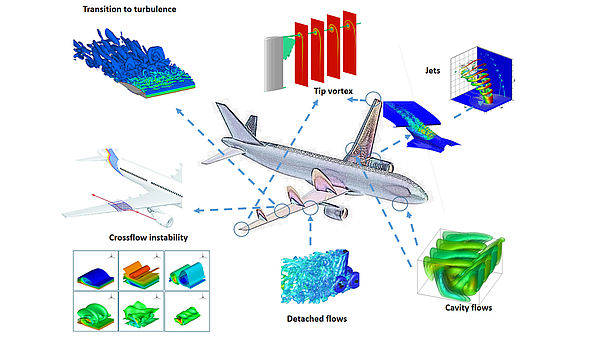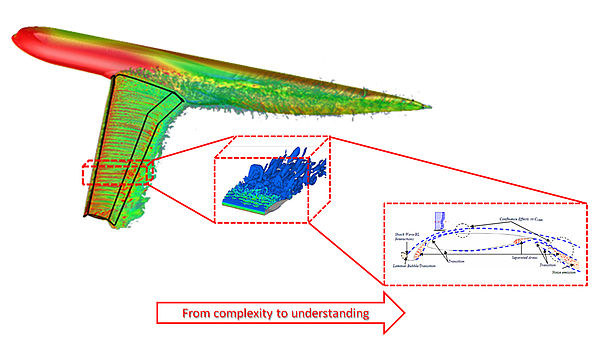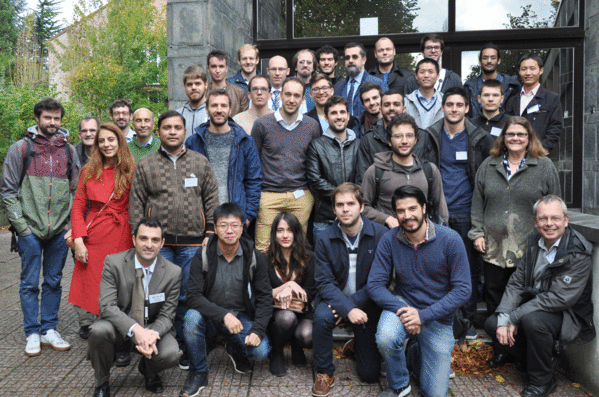The four year research of the SSeMID project (Stability and Sensitivity Methods for Industrial Design) has resulted in new methods and numerical simulation tools of great impact within the aerospace industry, since their application would lead to more efficient aircraft designs.
The SSeMID project, funded by European Union’s Framework Programme for Research and Innovation “Horizon 2020” under the Marie Sklodowska-Curie Innovative Training Programme, has been coordinated by the Universidad Politécnica de Madrid (UPM). Under the leadership of the researcher of the School of Aeronautical and Space Engineering (ETSIAE) Eusebio Valero, researchers and PhD students proceeding from five universities were involved in this project: Universidad Politécnica de Madrid, Spain; Imperial College London and University of Cambridge, United Kingdom; KTH, Sweden; Katholieke Universiteit Leuven, Belgium; three research centres in the aeronautical field: the Office National d'Etudes et de Recherches Aérospatiales, France; Deutsches Zentrum für Luft - und Raumfahrt eV., Germany; and the Von Karman Institute, Belgium; as well as two relevant companies in this sector: Airbus, United Kingdom and NUMECA, Belgium. In addition, two American universities, Purdue and San Diego, contributed to this project.
 Examples of areas where aerodynamic stability and flow control are applied in an aircraft
Examples of areas where aerodynamic stability and flow control are applied in an aircraft
The research carried out has been focused on flow stability, as a key element to understand the current limitations of aircraft designs, and to develop new numerical methodologies as well as new model generation which are required by the aircraft manufacturing industry in order to obtain new solutions. SSeMID has allowed maturing and industrialising new methods whose main goal is obtaining sensitivity maps of critical aerodynamic features that also have a great impact on aircraft performance and the environment, such as noise or fuel consumption.
The direct application of this new methodology is the flow control and the advanced optimisation. Flow control is an emerging technology that develops a variety of techniques by which the aerodynamic performance can be enhanced to levels beyond those achieved so far, only by generating new surface geometry, radically changing current concepts within industrial designs. The application of stability and sensitivity analysis provides very valuable information to design engineers on "how and where" it is required to address in order to achieve an optimal design.

Passive flow separation control at the trailing edge of a blade. Results obtained in SSEMID
Beneficial impact on industry and society
These new tools help to the future generations of aircraft to be developed in less time and with a lower cost, using more efforts in simulation and less in expensive experimental tests, without losing safety and reliability. Precise computational tools lead to a reduction of million euros in operating costs per plane and per year. In terms of efficiency, those new aircraft would reduce carbon dioxide (CO2) and nitrogen oxides (NOx) emissions into the atmosphere; reduce the noise level, particularly during take-off and landing manoeuvres, both of which so negatively impact on areas surrounding urban centres. “Therefore, the benefits of optimising aeronautical technology will not only reach the aeronautical industry, but ultimately they will spread across the society at large," explains Professor Eusebio Valero.

Complex flow configurations are understood thanks to new numerical methods
Participation of PhD students
16 young researchers have been involved in SSeMID where they have completed their doctoral dissertations within an international and cross-sectional environment. They have participated actively in the innovation process by developing new methodologies with the aim of incorporating them into the industrial design process. Thus, they have acquired an overall view of the design process: from the mathematical understanding of numerical methods for engineering simulation to their industrial application on real problems. Eusebio Valero considers to be highly relevant the learning they have achieved and not only in terms of training: “PhD students have self-experienced how the results of their research has a directly impact on the progress of the aviation industry," he emphasised.

Group photo. SSeMID project researchers

